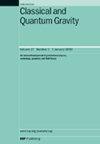增加费米子数量时爱因斯坦-狄拉克系统静态解向现象学行为的转变
IF 3.7
3区 物理与天体物理
Q2 ASTRONOMY & ASTROPHYSICS
引用次数: 0
摘要
1999年,Finster等人首次用数值方法构造了爱因斯坦-狄拉克系统的静态球对称解(1999 Phys)。Rev. D59 104020)在两个费米子的情况下。2020年,Leith等人推广了这一结果。Rev. D101 106012)到一个由偶数κ的费米子组成的系统。他们为。本研究的目的是比较爱因斯坦-狄拉克系统的静态解与爱因斯坦-弗拉索夫系统的静态解随费米子数目的增加(即对于)的性质。由于爱因斯坦-弗拉索夫系统是一个完全经典的物理模型,而爱因斯坦-狄拉克系统是半经典的,因此具有量子特征,这个框架提供了一个很好的机会来研究从量子到经典行为的转变。事实证明,即使对于相对较少的粒子,溶液的特征也非常相似。对于这两个系统,我们发现高度相对性的解具有具有惊人相似特征的多峰结构。我们还研究了解的最大紧致比。两个系统的解都具有关于最大紧度比的基本性质,并服从andrsamasson (2008 J. Differ)中导出的不等式。Equ.245 2243 - 66)。进一步,我们研究了爱因斯坦-狄拉克系统解的压力分量的符号。对于较小的κ值,存在径向压力为负的区域。这些区域随着κ的增加而消失。这支持了我们的解释,即随着费米子数量的增加,从量子行为过渡到经典行为。本文章由计算机程序翻译,如有差异,请以英文原文为准。
The transition to phenomenological behaviour of static solutions of the Einstein–Dirac system for an increasing number of fermions
Static spherically symmetric solutions to the Einstein–Dirac system were constructed numerically for the first time in 1999 by Finster et al (1999 Phys. Rev. D59 104020) in the case of two fermions. In 2020 this result was generalized by Leith et al (2020 Phys. Rev. D101 106012) to a system consisting of an even number κ of fermions. They constructed solutions for . The purpose of the present investigation is to compare the properties of static solutions of the Einstein–Dirac system with static solutions of the Einstein–Vlasov system as the number of fermions increases, that is, for . Since the Einstein–Vlasov system is a fully classical physical model, whereas the Einstein–Dirac system is semiclassical and thus has a quantum signature, this framework provides an excellent opportunity to study the transition from quantum to classical behaviour. It turns out that even for a comparatively small number of particles, the features of the solutions are remarkably similar. For both systems, we find highly relativistic solutions having a multi-peak structure with strikingly similar characteristics. We also investigate the maximum compactness ratio of the solutions. The solutions of both systems share the fundamental properties regarding the maximum compactness ratio and obey the inequality derived in Andréasson (2008 J. Differ. Equ.245 2243–66). Furthermore, we investigate the sign of the pressure components of solutions of the Einstein–Dirac system. For small values of κ, there are regions where the radial pressure is negative. These regions disappear as κ increases. This supports the interpretation we make as a transition from quantum to classical behaviour as the number of fermions increases.
求助全文
通过发布文献求助,成功后即可免费获取论文全文。
去求助
来源期刊

Classical and Quantum Gravity
物理-天文与天体物理
CiteScore
7.00
自引率
8.60%
发文量
301
审稿时长
2-4 weeks
期刊介绍:
Classical and Quantum Gravity is an established journal for physicists, mathematicians and cosmologists in the fields of gravitation and the theory of spacetime. The journal is now the acknowledged world leader in classical relativity and all areas of quantum gravity.
 求助内容:
求助内容: 应助结果提醒方式:
应助结果提醒方式:


